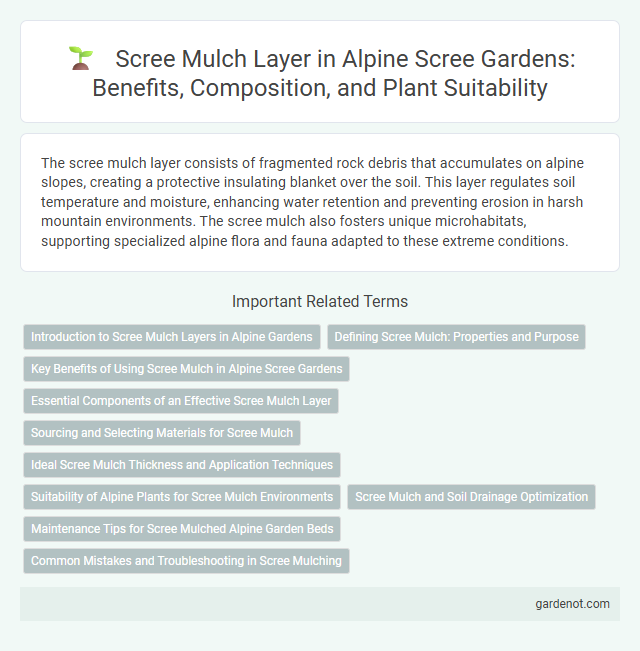The scree mulch layer consists of fragmented rock debris that accumulates on alpine slopes, creating a protective insulating blanket over the soil. This layer regulates soil temperature and moisture, enhancing water retention and preventing erosion in harsh mountain environments. The scree mulch also fosters unique microhabitats, supporting specialized alpine flora and fauna adapted to these extreme conditions.
Introduction to Scree Mulch Layers in Alpine Gardens
Scree mulch layers in alpine gardens mimic natural rock debris, providing excellent drainage and temperature regulation essential for high-altitude plant survival. These layers reduce soil erosion, retain moisture, and create a stable microenvironment that supports delicate alpine flora. Incorporating scree mulch enhances root protection and promotes healthy growth by replicating native alpine conditions.
Defining Scree Mulch: Properties and Purpose
Scree mulch consists of loose, angular rock fragments typically found on steep alpine slopes, providing crucial insulation and moisture retention for underlying soils. Its porous structure facilitates excellent drainage while protecting plant roots from extreme temperature fluctuations and erosion. This natural mulch enhances soil fertility by slowly releasing minerals essential for alpine vegetation growth.
Key Benefits of Using Scree Mulch in Alpine Scree Gardens
Scree mulch in alpine scree gardens enhances soil drainage and prevents erosion by mimicking natural rocky debris, creating an optimal environment for drought-tolerant plants. This mulch layer also moderates soil temperature fluctuations, crucial for alpine species sensitive to extreme cold and heat. Using scree mulch reduces weed growth, minimizing competition for nutrients and water in high-altitude garden ecosystems.
Essential Components of an Effective Scree Mulch Layer
An effective scree mulch layer for alpine environments requires coarse-grained materials such as gravel and small stones to ensure proper drainage and prevent soil erosion. Incorporating organic matter, like decomposed leaf litter or moss, helps retain moisture while promoting microbial activity crucial for root development. The mulch layer must be well-structured to mimic natural scree conditions, supporting plant stability and nutrient cycling in harsh, high-altitude climates.
Sourcing and Selecting Materials for Scree Mulch
Scree mulch layers for alpine environments require sourcing durable, coarse materials such as fragmented rock, gravel, and mineral-rich debris that mimic natural scree composition. Selecting materials involves prioritizing local, weather-resistant stones to ensure proper drainage, soil stability, and microhabitat support for alpine flora. Incorporating well-graded particles with angular shapes enhances interlocking properties and prevents erosion in steep, high-altitude scree slopes.
Ideal Scree Mulch Thickness and Application Techniques
Ideal scree mulch thickness ranges from 5 to 10 centimeters, balancing moisture retention and drainage crucial for alpine scree plants. Application techniques emphasize spreading mulch evenly over root zones without compacting, maintaining aeration and preventing fungal growth. Regular monitoring and replenishment ensure optimal thickness is sustained, supporting plant resilience in harsh alpine environments.
Suitability of Alpine Plants for Scree Mulch Environments
Alpine plants exhibit exceptional adaptability to scree mulch environments due to their tolerance to fast-draining, nutrient-poor substrates and fluctuating moisture levels. Species such as Saxifraga and Sedum thrive in these conditions by developing deep root systems that stabilize the loose scree and access water reserves beneath the mulch layer. The scree mulch's insulating properties also protect alpine flora from temperature extremes and desiccation, promoting robust growth and biodiversity in mountainous terrains.
Scree Mulch and Soil Drainage Optimization
The scree mulch layer in alpine environments enhances soil drainage by promoting rapid water percolation through coarse, angular rock fragments. This mulch mimics natural scree surfaces, reducing soil compaction and preventing waterlogging, which supports root oxygenation and plant health. Optimized soil drainage in scree mulch layers mitigates erosion and maintains moisture balance essential for alpine vegetation survival.
Maintenance Tips for Scree Mulched Alpine Garden Beds
Maintaining scree mulch in alpine garden beds involves regular inspection to prevent soil erosion and ensure proper drainage, critical for plant health in rocky terrain. Replenishing the scree layer annually helps retain moisture and suppress weeds, important for sustaining delicate alpine species. Removing organic debris and avoiding heavy foot traffic preserves the integrity of the scree mulch, supporting the stability and aesthetics of the alpine garden.
Common Mistakes and Troubleshooting in Scree Mulching
Scree mulch layers often suffer from improper particle size selection, which can hinder drainage and root aeration, leading to plant stress in alpine environments. Incorrect application thickness can cause either excessive moisture retention or insufficient protection against soil erosion, disrupting the delicate balance required for scree habitat preservation. Regular monitoring and adjustment of mulch composition based on site-specific conditions help prevent common issues such as compaction, weed infiltration, and nutrient imbalances in alpine scree mulching systems.
Scree mulch layer Infographic

 gardenot.com
gardenot.com